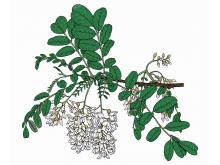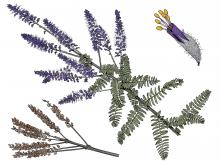Trees, Shrubs and Woody Vines
Media

Species Types
Scientific Name
Diospyros virginiana
Description
Persimmon is best known in the fall, when its orange, plumlike fruits come on. Be careful, however, to make sure a persimmon is ripe before you pop it into your mouth, or you could have a puckery surprise!
Media

Species Types
Scientific Name
Maclura pomifera
Description
Osage orange is a densely branched, short-trunked, thorny tree. It bears weird-loooking, softball-sized, chartreuse, brainlike fruits, which often lie beneath the tree in abundance in autumn.
Media

Species Types
Scientific Name
Rhus spp.
Description
Sumacs are shrubs or small trees that often form colonies from their creeping, branched roots. The foliage usually turns brilliant shades of red in early autumn. The clusters of berrylike fruits are red.
Media

Species Types
Scientific Name
Cornus spp.
Description
Missouri’s five species of dogwoods are shrubs or small trees with distinctive flowers, fruits, and bark. The fruits may be red, white, or blue. The leaves have characteristic arching veins.
Media

Species Types
Scientific Name
Robinia pseudoacacia
Description
Black locust, a member of the bean family, is easy to appreciate in May and June, when its showy white clusters of flowers perfume the breeze with their sweet smell. Bees like the flowers, too.
Media

Species Types
Scientific Name
Toxicodendron radicans
Description
Poison ivy is a toxic plant that contains an oil in all its parts that, if you come into contact with it, can cause an intense skin reaction. Learn to recognize it, and sidestep it on your outings.
Media

Species Types
Scientific Name
Smilax hispida (syn. S. tamnoides var. hispida)
Description
Bristly greenbrier is a stout woody vine with bristlelike black spines, climbing high by tendrils to a length of 40 feet. It is the most common greenbrier in Missouri and is found statewide.
Media

Species Types
Scientific Name
Amorpha canescens
Description
Lead plant is a densely hairy small shrub producing tight, elongated spikes of small purple flowers from May through August. It grows in prairies, glades, and savannas.
Media

Species Types
Scientific Name
Cocculus carolinus
Description
Carolina moonseed is a slender, twining vine. It is scattered in southern and eastern Missouri. It bears clusters of bright red, somewhat flattened fruits. The disk-shaped seeds are spiraled like a snail shell.
See Also
About Trees, Shrubs and Woody Vines in Missouri
There are no sharp dividing lines between trees, shrubs, and woody vines, or even between woody and nonwoody plants. “Wood” is a type of tissue made of cellulose and lignin that many plants develop as they mature — whether they are “woody” or not. Trees are woody plants over 13 feet tall with a single trunk. Shrubs are less than 13 feet tall, with multiple stems. Vines require support or else sprawl over the ground.





















